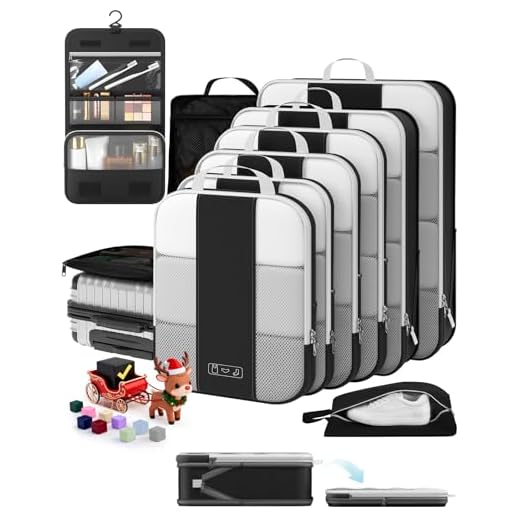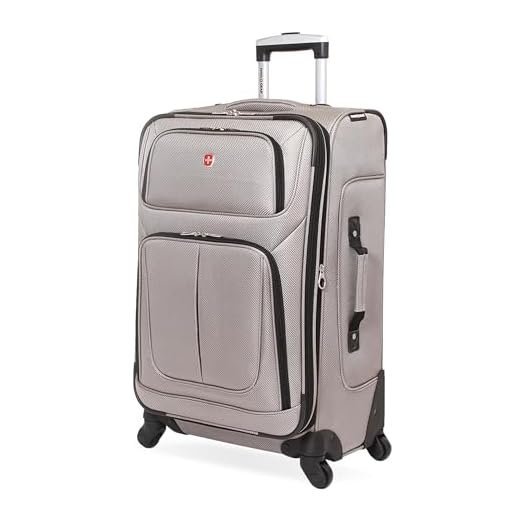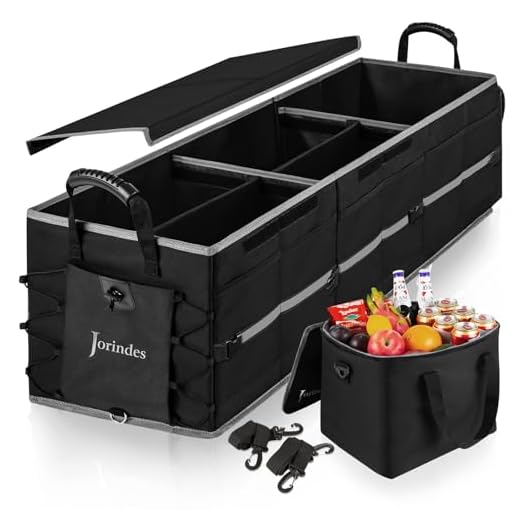



For optimal packing, a hatchback or subcompact model can accommodate approximately 11 to 13 cubic feet of storage space with the rear seats up. If you lower the rear seats, this volume can expand significantly, reaching around 30 cubic feet, allowing for larger items like suitcases, strollers, or sports equipment.
A typical passenger in this category comfortably transports two medium-sized bags or four carry-ons with seats in place. Prioritize soft-sided bags for better fitting, as they can easily conform to available spaces. For longer trips, consider distributing items evenly throughout the trunk and cabin, using the areas behind the front seats to maximize every inch.
Before embarking on your next adventure, assess the dimensions of both your belongings and the storage areas in your vehicle. Utilizing packing organizers or vacuum-sealed bags can also enhance storage efficiency, making the most of any compact ride. With careful planning, small cars can effectively manage diverse packing needs without sacrificing comfort for passengers.
Capacity for Your Gear in a Smaller Vehicle
A smaller vehicle typically accommodates around 10 to 12 cubic feet of storage space. This volume generally allows for a combination of two to three medium-sized suitcases or a mix of soft bags and personal items.
When packing, consider using soft-sided bags as they often provide more flexibility to maximize available space. Placing bags strategically by utilizing footwells and rear seat areas can create additional room for smaller items.
Opt for practical packing solutions, such as packing cubes, which help organize clothing and maximize space efficiency. If you’re seeking budget-friendly options, check out the best luggage to buy on a budget to ensure you have the right gear for your road trip.
Additionally, assess the need for any items you may bring along to avoid unnecessary bulk. Streamlining your gear can enhance overall comfort throughout your travels.
Understanding Compact Car Dimensions
For a practical selection, precise measurements are crucial. Most small vehicles have dimensions around 14 to 15 feet in length, 5 to 6 feet in width, and approximately 4.5 to 5 feet in height. Understanding these figures aids in gauging interior space effectively.
| Dimension | Average Measurement |
|---|---|
| Length | 14 to 15 feet |
| Width | 5 to 6 feet |
| Height | 4.5 to 5 feet |
Interior volume typically ranges from 85 to 100 cubic feet. Additionally, the trunk capacity, often essential for storage, can range from 12 to 15 cubic feet, depending on design choices and model variations.
Loading space can also be optimized by utilizing folding rear seats, which can significantly expand the usable area when needed. This flexibility enables transport of larger items, making small vehicles versatile for varying needs.
Common Types of Luggage and Their Sizes
Choosing the right travel bags is crucial for ensuring a smooth experience. Below are typical types of bags along with their dimensions.
1. Carry-On Bag
- Dimensions: Up to 22 x 14 x 9 inches (56 x 36 x 23 cm)
- Capacity: Approximately 40 liters
- Use: Ideal for short trips, fits in overhead compartments.
2. Checked Suitcase
- Dimensions: 24 x 16 x 10 inches (61 x 41 x 25 cm) to 30 x 20 x 12 inches (76 x 51 x 30 cm)
- Capacity: Ranges from 60 to 100 liters
- Use: Designed for longer journeys, stored in the hold.
3. Duffel Bag
- Dimensions: 18 x 10 x 10 inches (46 x 25 x 25 cm) to 30 x 15 x 15 inches (76 x 38 x 38 cm)
- Capacity: Varies from 30 to 100 liters
- Use: Versatile option for gym, travel, and short getaways.
4. Backpack
- Dimensions: 18 x 12 x 6 inches (46 x 30 x 15 cm) to 25 x 15 x 10 inches (64 x 38 x 25 cm)
- Capacity: Generally from 20 to 50 liters
- Use: Excellent for hiking, urban travel, or casual trips.
5. Garment Bag
- Dimensions: 22 x 44 inches (56 x 112 cm) unfolded
- Capacity: Designed for formal wear, typically accommodates up to 5 suits or dresses
- Use: Keeps clothing wrinkle-free during transport.
Selecting the appropriate type of travel container influences convenience and organization while on the move. Consider the duration of your trip and the items you need to bring when making your choice.
Maximizing Space in the Trunk
Utilize packing cubes to organize items effectively. These modular containers help compress clothing and allow for better stacking, maximizing available volume.
Consider soft-sided bags for their flexibility. Unlike rigid suitcases, they can conform to odd spaces, allowing for more efficient use of the trunk’s contours.
Employ vertical stacking techniques. Place heavier items at the bottom and lighter ones on top. This keeps everything stable while optimizing the space.
Remove unnecessary internal structures from bags. Straps, wheels, and bulky designs can consume valuable space. Reducing these elements enhances overall compactness.
Utilizing Trunk Accessories
Add a cargo net or organizer to keep smaller items from shifting. This not only maintains order but also prevents any wasted space between bags.
Invest in trunk dividers if available. These can help separate various types of gear or equipment, allowing for a more systematic organization.
Creative Solutions for Odd-Shaped Items
Make use of every nook and cranny. Shoes, for instance, can be stuffed with socks, and gaps between larger items can house smaller necessities. This approach contributes to overall volume efficiency.
Evaluate the layout regularly. After loading, take a moment to assess and rearrange items for optimal space utilization. Adjustments can significantly increase your capacity.
Tips for Packing Efficiently
Roll clothing instead of folding to save space and reduce wrinkles. Utilize packing cubes to keep items organized and make packing easier. They can help fit more items into confined spaces.
Prioritize Items
Identify essentials and pack those first. Non-essential items can be added later, but ensure that the most necessary belongings are easily accessible.
Use Empty Spaces
Fill shoes with smaller items like socks or toiletries to utilize every inch. Additionally, consider using soft bags instead of hard-shell cases; they can conform to the available space better.
Underpacking is often advisable; leave some room for any items you may acquire during travel. Lastly, utilize compression bags for bulky clothing to significantly reduce volume.
Comparing Different Compact Car Models
For those who prioritize practicality alongside agility, evaluating various small vehicle types is crucial. Different models offer unique specifications influencing storage capabilities and overall functionality.
- Honda Civic: Known for its spacious trunk and rear seat flexibility, it accommodates various bags, including larger items, thanks to its approximate trunk space of 15.1 cubic feet.
- Toyota Corolla: This model provides a functional trunk space, clocking in around 13 cubic feet. The rear seats fold down, enhancing cargo options and usability for everyday tasks.
- Ford Focus: Offering about 23.3 cubic feet of cargo area, this choice stands out with versatile seating arrangements and additional storage compartments, ideal for transporting diverse items.
- Volkswagen Golf: A hatchback design contributes to around 22.8 cubic feet of capacity. Ideal for both leisure and practical needs, it allows for maximal loading flexibility.
When selecting a model, consider personal needs, frequency of travel, and item types. For example, a model like the best anthias for reef tank might align more with enthusiasts of a specific hobby, while another model could be more family-oriented.
- Hyundai Elantra: Known for its smooth ride and decent trunk space of 14.2 cubic feet, it offers a good balance between passenger comfort and cargo management.
- Kia Forte: Similar to the Elantra, it provides an estimated 15.3 cubic feet, with a remarkably spacious cabin conducive to carrying various daily essentials.
Assessing these variations effectively allows potential drivers to make informed choices, ensuring they’ll accommodate professional or personal transport needs. Evaluate factors, including ease of access to storage areas and adaptability for various journey types.
Real-Life Examples of Luggage Capacity
Choosing a vehicle involves understanding its utility in practical scenarios. A typical hatchback or sedan can accommodate two large suitcases and a few smaller bags without compromising comfort. For instance, the Honda Civic is reported to handle around 14 cubic feet of storage, which could easily hold a combination of one big suitcase (27 inches) and several carry-ons.
Examples from Popular Models
The Toyota Corolla’s trunk space, approximately 13 cubic feet, allows similar packing possibilities. Users have successfully transported a set of golf clubs alongside business luggage, balancing the space efficiently. In contrast, the Ford Focus offers slightly more spacious rear sections, enabling an additional backpack for short trips.
Real-Life Packing Scenarios
A family road trip in a Volkswagen Golf showcased its versatility, where four passengers managed to stow away two medium-sized bags, a diaper bag, and a stroller. On the other end, a weekend getaway in a Mini Cooper highlighted its snug dimensions, accommodating a couple’s overnight bags along with a picnic basket by utilizing vertical space creatively.









